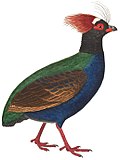Gracilisgallus
Gracilisgallus (meaning "slender chicken") is an extinct genus of phasianid birds known from the Late Miocene–Early Pliocene Linxia Basin (Liushu Formation–Hewangjia Formation) of China. The genus contains a single species, Gracilisgallus linxia, known from an almost complete articulated skeleton. Gracilisgallus is likely a close relative of modern grouse and turkeys. Panraogallus, another phasianid, is one of many other well-preserved birds known from the Liushu Formation.[1][2] Discovery and namingThe Gracilisgallus holotype specimen, IVPP V30721, was discovered in outcrops bordering the upper Liushu Formation and lower Hewangjia Formation near Shi-li-dun village in Gansu Province, China. The specimen is a nearly complete, articulated skeleton preserved three-dimensionally. Some regions, such as the back of the skull, the lower part of the left hindlimb, and parts of the pelvis, are missing or poorly preserved.[1] In 2025, Ting-Yu Yu and Zhi-Heng Li described Gracilisgallus linxia as a new genus and species of extinct phasianid bird based on these fossil remains. The generic name, Gracilisgallus, combines the Latin words gracilis, meaning "slender", and gallus, meaning "chicken" ("rooster"), in reference to the slender morphology of the taxon's skeleton. The specific name, linxia, references the type locality in the Linxia Basin.[1] References
|
||||||||||||||||||||||

















